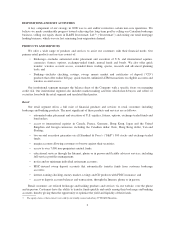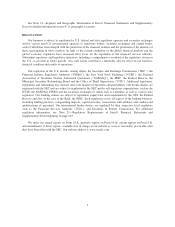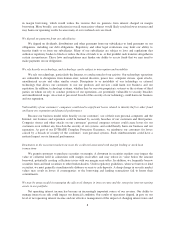eTrade 2008 Annual Report Download - page 15
Download and view the complete annual report
Please find page 15 of the 2008 eTrade annual report below. You can navigate through the pages in the report by either clicking on the pages listed below, or by using the keyword search tool below to find specific information within the annual report.Risks Relating to Owning Our Stock
We are substantially restricted by the terms of our corporate debt
In June 2004, we issued an aggregate principal amount of $400 million of senior notes due June 2011. In
September and November 2005, we issued an additional aggregate principal amount of $100 million of senior
notes due June 2011, $600 million of senior notes due September 2013 and $300 million of senior notes due
December 2015. In November 2007 and January 2008, we issued a total of $2.1 billion of 12
1
⁄
2
% springing lien
notes due 2017. The indentures governing these notes contain various covenants and restrictions that limit our
ability and certain of our subsidiaries’ ability to, among other things:
• incur additional indebtedness;
• create liens;
• pay dividends or make other distributions;
• repurchase or redeem capital stock;
• make investments or other restricted payments;
• enter into transactions with our stockholders or affiliates;
• sell assets or shares of capital stock of our subsidiaries;
• receive dividend or other payments from our subsidiaries; and
• merge, consolidate or transfer substantially all of our assets.
As a result of the covenants and restrictions contained in the indentures, we are limited in how we conduct
our business and we may be unable to raise additional debt or equity financing to compete effectively or to take
advantage of new business opportunities. Each of these series of senior notes contain a limitation, subject to
important exceptions, on our ability to incur additional debt if our Consolidated Fixed Charge Coverage Ratio is
less than or equal to 2.50 to 1.0. As of December 31, 2008, our Consolidated Fixed Charge Coverage Ratio was
(0.5) to 1.0. The terms of any future indebtedness could include more restrictive covenants.
We cannot assure that we will be able to remain in compliance with these covenants in the future and, if we
fail to do so, that we will be able to obtain waivers from the appropriate parties and/or amend the covenants.
The interests of our largest shareholder may conflict with the interests of other shareholders
At December 31, 2008, Citadel owned approximately 89.4 million shares of our common stock, which
represents approximately 16% of the outstanding shares. In addition, Citadel is our largest creditor through its
ownership of approximately $2.1 billion of our corporate debt. Citadel is an independent entity with its own
investors and is entitled to act in its own economic interest with respect to its equity and debt investments in
E*TRADE. For example, following April 29, 2008, Citadel was generally free under the terms of the Investment
Agreement to sell the equity securities it received under the Investment Agreement and any such sales may have
a depressing effect on the trading price of our common stock. In addition, Citadel’s 12
1
⁄
2
% springing lien notes
contain restrictive covenants and as a holder of in excess of a majority of the springing lien notes, Citadel has a
right to declare defaults and enforce remedies just like any other lender for so long as Citadel retains a majority
of the springing lien notes. Finally, in pursuing its economic interests, Citadel may make decisions with respect
to fundamental corporate transactions which may be different than the decisions of shareholders who own only
common shares.
The market price of our common stock may continue to be volatile
From January 1, 2006 through December 31, 2008, the price per share of our common stock ranged from a
low of $0.79 to a high of $27.76. The market price of our common stock has been, and is likely to continue to be,
highly volatile and subject to wide fluctuations. In the past, volatility in the market price of a company’s
12
























